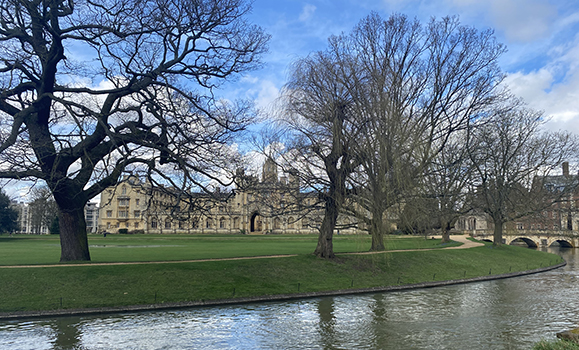One of Dalhousie University’s most accomplished young researchers recently returned from spending six months in the University of Cambridge’s Yusuf Hamied Department of Chemistry after receiving the prestigious Royal Society Wolfson Visiting Fellowship.
Dr. Erin Johnson, a professor in the Department of Chemistry and the Herzberg-Becke Chair in Theoretical Chemistry, was nominated for the Fellowship by Dr. Angelos Michaelides, the 1968 Professor of Chemistry at the University of Cambridge.
The Fellowship enables UK universities to host a talented international researcher for up to 12 non-consecutive months. Visiting fellows receive a bursary of up to 80,000 British pounds ($142,000 Canadian) per year, with additional funding provided for research and equipment, as well as relocation costs.
Having previously visited Cambridge for a seminar and conference, Dr. Johnson was eager to spend a six-month sabbatical there from January through June 2024, exploring research opportunities and meeting potential collaborators.

Dr. Erin Johnson.
Building a bigger network
Now back at Dal, she will return to England for another six months in January 2025.
“I tremendously enjoyed the experience,” she says, reflecting on a “scientifically invigorating” first spell at Cambridge. The Fellowship also allowed her the opportunity to travel and give seminars at other institutions across the UK, including University College London, the University of York, and the University of Warwick.
“It was a great experience to interact with a broader network of researchers,” she says.
As a theoretical chemist, Dr. Johnson works with computers rather than in a lab, predicting chemical reactions at the atomic level. A particular highlight of the sabbatical was collaborating with faculty from different departments, including with a physics professor in looking at methods for conformational searching.
“The most stable intramolecular arrangement of a molecule is called a conformer,” she explains. “Molecules can adopt different shapes, different conformers, if they are sufficiently flexible. For small molecules, it’s very easy to predict these shapes, but the larger the molecules grow, the more degrees of freedom there are, and the more complex this becomes.”

Another scene from Cambridge taken by Dr. Johnson.
Recharging intellectual batteries
While away from Dal, Dr. Johnson was able to meet virtually with members of her research group, including grad students she supervises.
“As theorists, my students and I can work from anywhere,” she says. “We just had to shift everything online like in the COVID days.”
Since joining Dal in 2015, Dr. Johnson has been awarded many honours in recognition of her achievements, including the 2017-18 Faculty of Science Killam Prize, the 2019 E.W.R Steacie Memorial Fellowship, the 2020 Rutherford Memorial Medal in Chemistry, and the 2021 Steacie Prize.
But even accomplished and prolific researchers need a break, and Dr. Johnson emphasizes the importance of finding a new routine.
“A sabbatical allows researchers to have a change of scenery, recharge their intellectual batteries, and interact with a new group of people,” she says. “My time at Cambridge was very valuable for developing new ideas and pursuing new research directions that wouldn’t have occurred to me just staying at Dal.”

